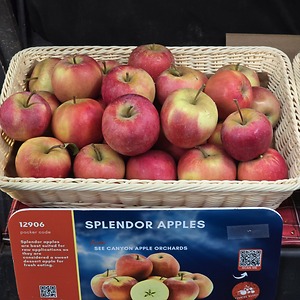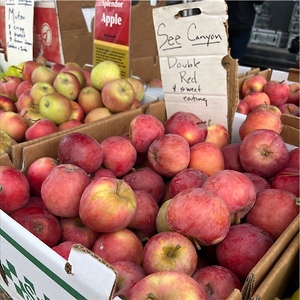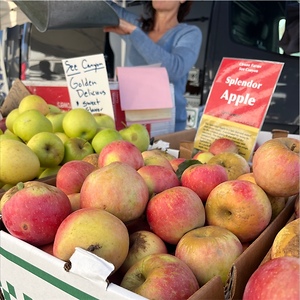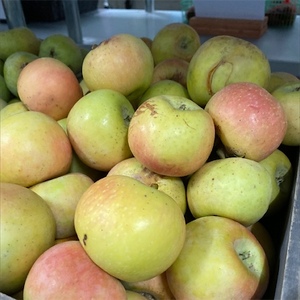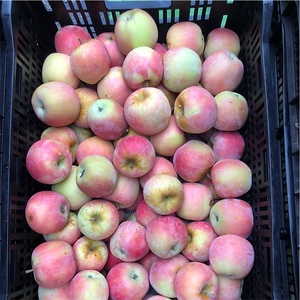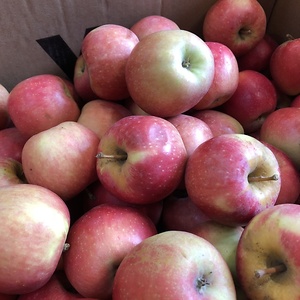

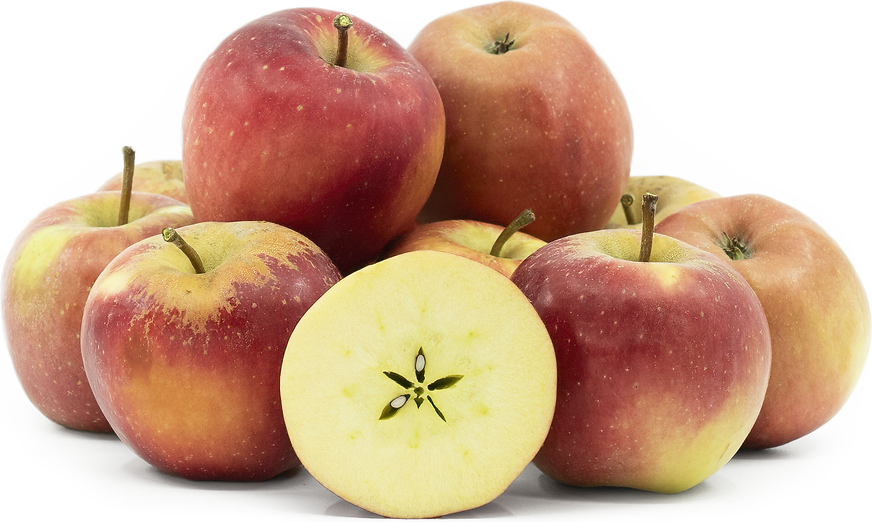
Splendour Apples
Estimated Inventory, lb : 0
This item was last sold on : 12/08/24
Description/Taste
Splendour apples are a medium to large varietal, averaging 6 to 7 centimeters in diameter, and have a conical to oblong shape with flat shoulders, a broad, curved center, and a narrow base. The fruits feature some ribbing and have a distinct five-knobbed crown at the bottom. The stem is slender, brown, and fibrous, set in a narrow, deep cavity, and the skin is thin, smooth, and taut. Splendour apples ripen from green to golden yellow shades and are covered in large patches of muted, red to dark red blush. The blush intensity varies, depending on sun exposure during cultivation, and the skin is also dotted with patches of rough, textured russeting and pale green lenticels. Splendour apples also bruise easily, making them challenging to cultivate and ship without external damage. Underneath the surface, the yellow flesh is firm, fine-grained, and aqueous with a crisp, succulent consistency. The flesh also encases a central fibrous core filled with tiny dark brown seeds. Splendour apples are edible raw and have a mild, sweet, and honeyed flavor combined with low acidity. Some consumers note that the variety may carry caramel and vanilla undertones and a slight metallic aftertaste, but this is subtle and often undetected.
Seasons/Availability
Splendour apples are harvested in the late fall and can be stored through the mid-spring.
Current Facts
Splendour apples, botanically classified as Malus domestica, are a variety from New Zealand belonging to the Rosaceae family. The late-season apples grew as a chance seedling in the mid-20th century in an orchard near Napier, New Zealand. Splendour apples were initially trialed as a new commercial cultivar after their discovery, but it was found that the skins were too thin and were damaged easily in the shipping process. The apples were deemed unsuitable for large-scale production and became a specialty variety grown in small, limited quantities. Splendour apples grow on upright, spreading deciduous trees that are slow in bearing, but once they begin fruiting, they produce high yields of large fruits. The variety is vigorous and resistant to fire blight and is primarily found in home gardens and specialty orchards. Splendour apples are also known as Splendor, Starksplendor, and Stark Splendour apples, and the variety is favored for its honeyed sweetness, consumed as a fresh eating or dessert cultivar.
Nutritional Value
Splendour apples are a source of vitamin C to boost the immune system, fiber to regulate the digestive tract, potassium to balance fluid levels within the body, and vitamin E to protect the cells against the damage caused by free radicals. The variety also provides calcium to protect bones and teeth, vitamin A to maintain healthy organ functioning, iron to produce the protein hemoglobin for oxygen transport through the bloodstream, copper to develop connective tissues, and other nutrients, including magnesium, boron, zinc, and vitamin K. The apple's pigmented skin contains anthocyanins, natural compounds with antioxidant-like properties that help reduce inflammation.
Applications
Splendour apples have a mild, sweet, and honeyed taste suited for fresh and cooked preparations. The variety is typically consumed out of hand, and the skin can be left intact or peeled, depending on preference. Most consumers eat the peel with the flesh. Splendour apples can be sliced and tossed into salads, shredded into slaws, or layered on porridge, granola, parfaits, or other breakfast dishes. The fruits can also be displayed on charcuterie boards with nuts and cheese, mixed into fruit medleys, served with spreads, dips, and nut butter, or layered into sandwiches. While less common, some consumers in New Zealand incorporate Splendour apples into various baked goods such as cobblers, muffins, cookies, and pies. The variety is not well-known as a baking apple, but it is occasionally combined with tarter apple varieties to balance flavors. Splendour apples are also made into fritters, sauteed and used as a topping over ice cream, or simmered into jams, jellies, and apple sauce. Beyond culinary uses, Splendour apples can be blended into smoothies or pressed into cider and juices. Splendour apples pair well with nuts such as pecans, walnuts, and almonds, spices including cinnamon, cardamom, nutmeg, and cloves, caramel, vanilla, chocolate, herbs such as parsley, rosemary, and basil, and other fruits including melons, strawberries, stone fruit, and citrus. Whole, unwashed Splendour apples will keep up to three months when stored in the refrigerator’s crisper drawer.
Ethnic/Cultural Info
Splendour apples were released to the public through the efforts of Dr. Donald McKenzie, commonly known as Dr. Don, in the many organizations he was involved in throughout the 20th century. Dr. McKenzie is notably known for his part in popularizing Gala apples in 1965, one of the most famous varieties from New Zealand in the modern day. He also worked for the Department of Scientific and Industrial Research and was passionate about introducing new apple cultivars. Dr. McKenzie collaborated with Allan White and Dr. Richard Volz at the New Zealand Fruit Research Orchard, now known as Plant and Food Research, a government-owned breeding program, to release varieties, including Splendour. Dr. McKenzie passed away in an accident in 1988, but his legacy lives through the apple varieties he played a part in releasing. The New Zealand Tree Crop Association also gives an annual award named in Dr. McKenzie’s honor. This award features a walnut that was given to Dr. McKenzie in 1983 in Germany. It is said the walnut is millions of years old and was donated by Dr. McKenzie to the association, where it was placed in a clear epoxy on the top of the trophy.
Geography/History
Splendor apples are native to New Zealand and were discovered growing as a chance seedling in the orchard of Charles L. Roberts in Napier. The variety was first noticed in 1946 and is hypothesized to have been developed from a cross between Red Dougherty and Golden Delicious apples, but the true parentage is still unknown. Roberts submitted the new variety to Dr. Don McKenzie and the New Zealand Fruit Research Orchard in the mid-20th century, and the apples were extensively evaluated, bred, and tested at the research site in Havelock North in the Hawke’s Bay area of the North Island. In 1967, Splendour apples were officially released, but the variety never achieved large-scale commercial success due to its fragile skin. Despite their lack of commercialization, Splendour apples were still introduced worldwide and were planted that same year in the United States through the efforts of the Stark Bros. The variety was also sent to England and other parts of Europe. Today, Splendour apples are a specialty apple cultivated in limited quantities as a sweet dessert variety. The cultivar is also known for its contributions to apple breeding, being one of the parent varieties for Rockit™, Pacific Beauty, Pacific Queen, Pacific Rose™, Sunrise Magic, and Golden Gala. When in season, Splendour apples are sold directly through growers, farmer’s markets, and select retailers in New Zealand, Australia, Europe, Canada, and the United States. The variety is also sold in seed form through online nurseries worldwide for home garden plantings.



